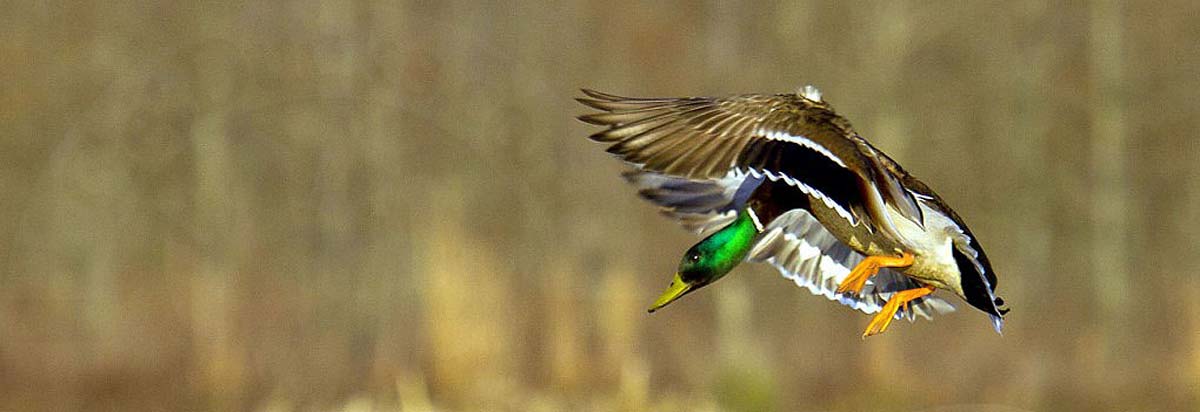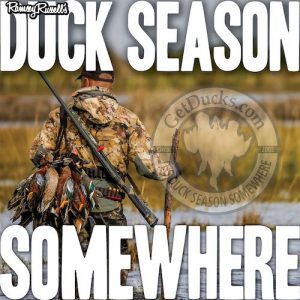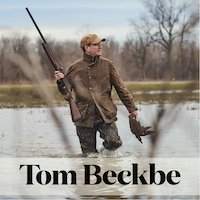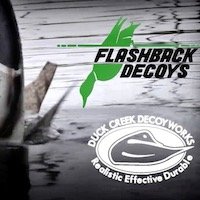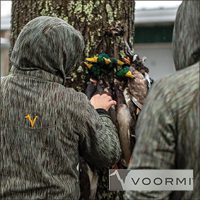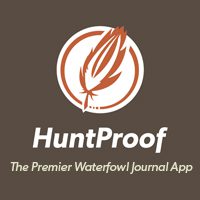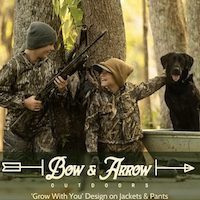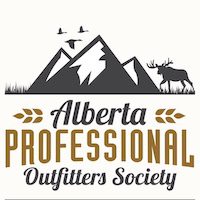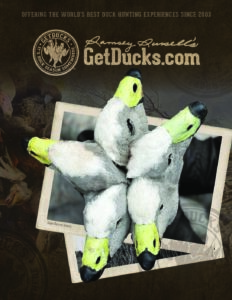Dr. Doug Osborne from University of Arkansas Monticello peels off from his research lab to catch us up on duck banding projects and what’s being learned about Arkansas mallards. While most duck hunters cherish leg bands on their lanyards, they provide a wealth of invaluable information for monitoring and research. We get into when mallards arrive and depart from Arkansas, seasonal movements, how Arkansas mallards are genetically exceptional relative to the Mississippi Flyway population, possible reasons increasingly fewer hen mallards are being recovered than were banded, and much more.
Ramsey Russell: Welcome back to MOJO’s Duck Season Somewhere podcast, where today I have got Mr. Doug Osborne from the University of Arkansas, Monticello, in the lab to talk about ducks. Doug, how the heck are you, man? Long time no see.
Doug Osborne: Yes, it’s been a minute. Good to see you. Appreciate opportunity to chat with you all again.
Ramsey Russell: We’re recording now, it’s matter of fact, it’s April Fool’s day, Doug and when we’re recording this. Are you done? Are you all done with your spring banding?
Doug Osborne: We are finished, yes, sir. And that’s the truth, you got the perfect candidate on here for fool’s day. Yes, sir, we’re wrapped up for the season and thinking about turkeys this weekend. My daughter’s 13 and wound up and I think I got a bird pinned down for her so.
Ramsey Russell: Are you a turkey hunter?
Doug Osborne: Oh, I try. I would not consider myself a turkey hunter. I’m trying, I’m going to try, I’ve killed a few and I think we got one for my daughter here this weekend.
Banding Birds in Arkansas
And this year, we caught 6300 ducks in basically 20, 25 days, 5300 of those were mallards.
Ramsey Russell: Well, I wish you all the very best luck. Thank the Lord almighty, I am not a turkey hunter, I didn’t get bit with that bug. My buddy Jim Cruz says, only because you hadn’t hunted the right turkey yet. My son, my oldest son has eat up with turkeys, he loved to turkey hunt and he’s good at it, but I’ve got other things on my mind other than chasing turkeys. Doug, tell me a little bit about you all’s banding program like, what did this year’s banding program entail? Like, how many ducks are you catching? How long are you banding? What kind of habitats? Tell me about banded ducks in Arkansas.
Doug Osborne: Yes, sir. So we started abandon winter banding postseason banding program about 14 years, 13 years now we’ve been doing this here in Arkansas and mostly as a monitoring tool. I mean, so really, as soon as hunting season ends, we’re baiting birds, we’re working on some folks across the state to help us get birds on bait, get them in a position, we need them, we’re focusing on catching them in the woods, mostly because it’s the least disturbing of the habitat types, if we catch them in the woods, the ones that get caught in the trap, the other ones that don’t get caught in the trap, they go back to roost and then we’ll go in and get the birds out of the trap after dark. So we’re not spooking birds off the next day, the ones we didn’t catch today, we’ll catch tomorrow. And so we’re not bumping birds, if we try to catch them in open fields where they’re roosting and spending a day, we’re always bumping birds, constantly bumping, bumping and this time of year, the energetics, it’s so important that these birds fuel back up and get ready for spring migration. So we are trying to have the least amount of disturbance and impact on these birds energetics as possible during this banding. The banding program usually lasts about the full month of February, the last couple of years we’ve been trickling into March, maybe a week or 2. So 4, pretty much 4 to 6 weeks, we’re working on catching them the first week after the hunting season, they’re pretty wound up from getting shot at and all that, we got to let them calm down. So, really, ultimately, in the long run, we end up with about 3 to 4 solid weeks of catching. And this year, we caught 6300 ducks in basically 20, 25 days, 5300 of those were mallards. So it was a great year, I mean, it was a really successful year. And mostly because we got good partners, we got people that we’ve trained to get the birds basically inside the wire and when they’re inside the wire, they call me and say, hey, we’re close and I show up and we lock the trap. Nobody locks the trap but us, but they at least get the wire standing in the woods and the birds are swimming in and out of it, it’s a heck of a process. So having, having partners on the landscape, that’ll help us get into those situations and then we move in to start capture once they get there.
Ramsey Russell: Doug, how long do a lot of those mallards typically hang around? And is there year to year variability? Like, I’m curious how long those mallards hang around, because we’ve been having a lot of conversations other, with other folks about the importance of late season water. But it just occurred to me as hunting down in Mexico, it was a real weird year, the timing and it was a real weird year with the migration this year, but I just wondered if that affected the timing of when those mallards would leave, you know I’m saying? Did they leave earlier than normal or did they hang around late or as late as normal?
Doug Osborne: I’ll just tell you, I think it’s the sun’s the day length schedule, really, I mean, ultimately what it boils down to, I mean, our transmitters, it seems like every year about the March 7 is the exodus out of here in terms of the transmitters. But yet a week and a half ago, I was out on a field site looking at a bottom and hardwood stand that we’re going to do some forest restoration on and we flush mallards out of there so they’re not all leaving. But around that March 7, it seems like, in terms of our transmitter data, we have a really a pretty good strong movement of birds out of this region around that March 7 range, but again, they’re not all gone. Some of our transmitters seem to stay back a little bit later, they’re gone now. And again and you go out, we go out like I said, I was out in the woods a week ago and had flushed birds out of some wetlands and so there’s still a few trickling hanging tight.
Ramsey Russell: Some of those transmitters that hang back, do those typically seem to be hatchier birds that probably hadn’t paired yet or could it be just adult breeders, too?
Doug Osborne: Yeah, that’s a good question. I don’t think I’ve really – I don’t think I’ve seen patterns in that, I suspect they’re probably birds that haven’t had paired and it may be an effect of the transmitter, possibly, but that’s part of the study we’re looking at right now. We’ve put out about 200 transmitters and 400 geolocators and some implants and I mean, we had a half a million dollar project funded over the last 2 years, specifically trying to pin down and quantify what the effect of that transmitter is. Is it slowing down their migration? Are they staying back longer because they got a device on them? Are they making smaller jumps right from here up? Are they making more stops along their spring migration because they have that extra weight on their back? We know they probably, you got a backpack on, it’s going to have some impact on these birds migration, on their aerodynamics and on their movements. In terms of using these data to drive policy decisions, we just need to be able to quantify what those impacts are.
Ramsey Russell: Right.
Gathering Information from Banded Waterfowl
Doug Osborne: So if we can quantify and say, hey, it looks like there’s probably a 2 or 3 day lag time in their migration because it has the transmitter. If that’s the case, then we say, well, we can’t estimate migration timing with back transmitters or we at least know what that impact is and we can account for that difference. And so using transmitter data to make policy decisions and habitat management decisions, we just need to know, be able to put our finger on and know exactly what that impact on that bird is so we can account for it and to make decisions.
Ramsey Russell: The revelations that have been forthcoming with the use of those transmitters is just mind blowing. For example, I grew up my whole life thinking of course ducks fly south, but they were just flying south willy nilly, I mean, they come into the state of Mississippi and they might jump all over the delta and that’s not the case. I mean, the last conversation we had, they have got extreme fidelity for certain pieces of property and I never will forget the story, one of your landowners, his son shot a hen widget 7ft from where it had been banded 3 years prior, that is just mind blowing.
Doug Osborne: Yeah.
Ramsey Russell: And do you still see that trend? There’s nothing changing, these birds are coming to their stomping grounds every year, aren’t they?
Doug Osborne: Yeah. I think there’s various sort of groups of birds, they call them, I learned this term down here from, from the locals in Arkansas, but there’s tribes of ducks, right? And so there’s those local, there’s those birds that are philopatric, they’re coming to that property no matter what they’ve been for generations been coming there. And then there’s still a group of birds of migrants that we hope will show up when that cold weather front pushes them down. But unfortunately, those are some of the things that we’re seeing is the change in that migration timing of some of those birds. And so back to one of your questions, but yes, we are really still seeing pretty high size phyllopatry both in transmitter birds, we get transmitter birds that come back to the same, even the same properties or really close, but we see it a lot in the bands as well because they’re the bands will probably have less impact on them and their ability to survive is probably better with just the band on it.
Ramsey Russell: I’ve heard that there’s a huge trade off in information, but I’ve heard that there’s somebody was telling me a little bit about the surgically implanted geo transmitters. Have you all started looking or fooling around without any?
Impact of Battery Life on Breeding Ground Data
So they’re not just under the skin, we literally are opening up the abdominal cavity and tucking it in there and stitching it to the inside wall of the cavity of the abdomen and stitching it back up.
Doug Osborne: Yes, sir. Last 2 years we put some implants in and they’re surgically implanted in the adoptable cavity. So they’re not just under the skin, we literally are opening up the abdominal cavity and tucking it in there and stitching it to the inside wall of the cavity of the abdomen and stitching it back up. So we’re licensed veterinarians from state wildlife agencies are putting those in for us. We’re seeing some there’s some trade-offs, there’s a lot of trade-offs to everything you do in life, including this one, they are not solar powered and so they’re not going to recharge. And so that battery life is pretty limited to and in last year, our transmitters all died in about July. So, we got pretty much a full migration, we got some information on the breeding grounds, but the batteries all went dead pretty much same time. So we could back off the amount of data we collect so they live longer, but what’s the trade off? Do you want a lot of data a short time or do you want a little bit of a data scattered over a longer time? So it just depends on what objective we’re really looking at. But relative to the backpacks, we got some backpacks that have been on for 3 years now. We’ve done 3 full migrations. And so because of that solar panel, it’s allowed a lighter weight battery that will recharge and we get longer life span out of those transmitters.
Ramsey Russell: In the context of you all’s research, Doug, are you all looking at the full migration of these birds or concentrating more on certain like Arkansas?
Doug Osborne: Yeah, that’s a good question. So our program right now, as of up till now, we only have a master’s degree program, so these are 2 graduate students that will come in and study for 2 years. And so up to now, I’ve really focused on local kind of questions like let’s answer a bunch of these local winter ecology related questions, because in a 2 year study, you want to have 2 field seasons, so you have a good amount – so you can quantify the variation across different years. And so if we’re answering these really localized questions over a couple of winters, that’s a pretty much capacity that a master’s student has time, really and ability to do. And so till now, I would say most of my questions have been very localized and it’s only because of the limitations of our graduate program. We actually are working on getting a PhD program, which is real exciting, I’m actually recruiting a PhD student right now to be my first PhD student in our lab, that will give us 4 year study. So now we can start to think about some of those bigger, larger scale questions. And so, yes, the answer is yes, I’ve really kind of focused on a bunch of localized questions and now that we got 4 or 5 years of winter data with transmitters on it, it’s allowed us to sort of expand out. We’re working with Cohen’s lab a bunch, he’s got a bunch of solid scientists working for him and we share data with him and we’re combining our data sets for larger scale analysis and better inferences at a larger scale. And so I would say moving forward now, I got a student on here now that’s looking at spring migration of hens only because I’ve seen lots of patterns in our banding data that we have less and less hens and there’s a lot of issues with that and quite or at least questions with that. So this, my new study is looking at spring migration, looking at the usage of private versus public lands, how important are our refuges? How important are set aside sanctuaries in state and federal refuges along that spring migration route? And then ultimately, where are these hens that we’re catching in South Arkansas or in Arkansas and a delta for the most part? Where are they settling on the breeding ground? Is it related at all to those heat maps that we see every year saying, hey, these are the best – These are the primary spots where the water is and there’s less water over here, this is in moderate and this is really drought conditions. How are our birds settling in relation to those maps that we can, as hunters continuously see?
Ramsey Russell: Like, in other words, are they flying north? Like, say she comes from Flaxcombe, Saskatchewan, but this year’s bone dry, will she move elsewhere and set up a new area?
Doug Osborne: Yeah, yep, just trying to identify how hard is she looking for nesting grounds up there? Like, we can see this, we’ll have the transmitter hen, say, land in Saskatchewan for a couple, 3 days and then she bounces around and you see her bouncing around with 3 or 4 or 5 different wetland areas and then next thing, she makes a big jump and she goes north and east, 50, 100 miles and then she bounces around a little bit more she’s searching. They’re master at searching, I mean, that’s what she’s doing, is searching for her best potential habitat options for her delay. So I want to see how many times are they stopping to look around and how long do they stay there before they decide this isn’t good enough, I’m leaving because I think there’s a lot of – This is a whole different conversation, I guess, but when they fly the surveys and account the breeding ponds on the prairies, it seems like it’s pretty, but they’re staying the same amount, the number of ponds isn’t changing at the frequency that the population appears to be. It’s not just the wetland, it’s not just the water that’s in a spot that these birds need to breed, it’s the grasslands around these wetlands that’s really important. And if we’re continuously converting the grasslands that’s around a wetland getting closer and closer with that disc and putting one more row of corn in, those birds can’t necessarily, may not necessarily be able to breed there because it doesn’t have the grasslands in close proximity. And so, our study is just to sort of start to dabble in some of the selection that goes on within these hens, the hen mallards on the breeding grounds and what sort of driving where they finally settle down and attempt to nest.
Ramsey Russell: Doug, I got a dumb question I just thought of and I’m full of dumb questions, like I told you, I’m always the dumbest guy in the room, but I just had this question. We think of wintering grounds, we think of breeding grounds, where do these madder ducks breed? I mean, when they make babies, are they doing it down here in the wintering ground? And then she’s flying back north before she makes a nest. Is she carrying those eggs with her or do they wait till they find a suitable nest site before they make babies?
Doug Osborne: No, it definitely doesn’t happen in wintering ground, I would say it could potentially happen somewhere in the northern part of that spring migration area. I think she would probably, I’m not a nesting ground guy, I’m a winter ground guy, so I need to, I need to get up to the prairies this year. But I think at some point along that spring migration, maybe they’re not completely settled yet. Is she starting to develop eggs right pre identification of where she’s going to lay them, when that pair is moving across the landscape. So it definitely doesn’t happen on the wintering grounds, it happens along that spring migration, probably closer to the breeding ground than it is to the wintering.
Ramsey Russell: I just got to wondering like, I just wonder if they come down here, they begin to pair bond, okay, we’re going to hit it off pretty good, let’s go make babies, they fly back north, I just wondered if they wait until Mama finds somewhere she knows she feels real good about – how wives will get just kind of get kind of nesty when the time is right? And I guess I just wondered I wonder if she’s got to find somewhere that she feels real good about making a clutch of eggs and if she doesn’t, if she just cuts him loose and says, maybe next time.
Doug Osborne: Yeah. Years ago, in my grad school era, I helped on a couple of spring migration studies where they were collecting some birds during spring, looking at diet and really what they were wanting to do is look at when are those birds shifting from high carb to high protein diets? And can we detect that? So I helped on a study in central and southern Illinois and collecting some female birds and there was a couple of hen mallards, I remember, that had eggs that were in the process of being developed and I know there wasn’t nesting in southern Illinois or central Illinois, they were on their way north. But she had already developed had some eggs developed if they were fertilized or not, that’s one thing, but that process was started during the spring migration north of that species. Now, other species may be different, not mallards, because mallards aren’t really known to dump their eggs in other mallard nests like some species. And so the ones that are potentially want to dump their eggs or 2 eggs in somebody else’s nest, I would say maybe that could potentially start even a little bit earlier.
Ramsey Russell: Yeah. And I can see where she’s got those eggs, she don’t have a suitable nest place if she’s just going to go dump it on her neighbor, let them take care of it, there’s a lot of different reasons that may be happening. But mallards don’t parasitic nest at all that I’m aware of.
Doug Osborne: Yeah. Not that I’m aware of either, but somebody listen, yeah, debunk that. But, you think about it though, it’s like the probability if she dumps her nest eggs in 3 or 4 different nests, the probability of one of those nests hatching and she getting her genetics carried on right, that’s the purpose of carrying your genetics on the next generation. If you put all your eggs in one basket and it gets crushed and you’re out of luck, but if you can scatter them out, you may have better luck.
Ramsey Russell: Last time I saw you, Doug, Forrest and I came over, we recorded a podcast at one of your landowners places and we’d gone out and done a little banding with you, and we were driving back home and Forrest, who, my turkey killing son that has got an off and going career in landscape, went to Mississippi state and we were driving back and he said I should have done that. I should have gotten to this program, I should have worked for Doug because he really loved what you were doing. And that’s been, I don’t know, 2 years, maybe 3 years ago that we met, your program has taken off leaps and bounds, how has your program grown like that the last few years? And what are some of the partnerships that you’ve reached out and are working with besides other just researchers? I hear your name come up all the time.
Waterfowl Banding Program for Research
And so we know, active monitoring, it helps us answer questions in hindsight and things that we don’t know what’s coming up, there may be some changes in waterfall in 10 years right from now that we don’t know what’s coming up, but with the banding data, with the transmitter data, we go back and see why that all happened.
Doug Osborne: Yeah, I appreciate it. We’re proud of it, I mean, I am with the University of Arkansas system and I’m a research scientist and so 70% of my appointments is research focused, so it gives me a bunch of time to write grants and work on partnerships and work on projects and that work comes out of Fayetteville main campus University, Arkansas and they put me on the Monticello campus to pair me with the forestry department there and to teach a few wildlife classes. So it’s been really good and the programs, again, I agree, it’s been a very successful program and we’ve had a lot of fun and really, I say that it’s got sort of 3 tiers, one is the research, the science that we get out of it and the banding program really started as a monitoring tool, and now, in hindsight, 10 years later, let’s see what patterns we’re finding in those ten years that may have driven some of the change that we’re seeing. And so we know, active monitoring, it helps us answer questions in hindsight and things that we don’t know what’s coming up, there may be some changes in waterfall in 10 years right from now that we don’t know what’s coming up, but with the banding data, with the transmitter data, we go back and see why that all happened. And so it’s been really good, the science and the monitoring and then the students, the training of the biologists, that’s why I’m in academia, that’s what drives my passion for what I do and my job is student mentoring, because we have to train the next generational biologists to use data, to use the knowledge they get from science and research, to make decisions that are data based and data driven. And so just mentoring, getting these students the experience they need on their resume to be competitive for jobs getting out. And we just we’ve been fortunate to have good funding partners and mostly in private individuals to get this program up and running, but I think states and federal agencies are starting to see the value of the data now that we’ve been collecting. And so I’ve been able to partner with multiple state agencies that are contributing funding for transmitter projects and the federal agencies have been really responsive because they’re real interested in seeing what can we learn about movements of these birds around our refuge, our sanctuaries, to help us make better policy decisions, for us to make better, to guide or to provide better hunting opportunities for the public that hunt private land. And so the data from several of our transmitter projects have – basically, has driven changes in local policy on refuges. So they’re going to potentially open up some new areas that’s never been hunted before and close some different areas so that we can spatially separate some of these sanctuaries better across these refuge systems and so there’s some of those things in the works on refuges. Interestingly, up at Hollow Bend National Wildlife Refuge in the Arkansas river valley of the state, that haven’t studied birds and movement all that much. We actually had a Congressman reach out to the refuge that was really interested in learning more about why there’s less birds on Hollow Bend National Wildlife Refuge than there used to be. So that led into a project that we put transmitters and bands on and we’re tracking the movement of birds around that landscape. The other day, I got a call saying, hey, I need a map of all the movements of birds around Hollow Bend National Wildlife Refuge because there’s some policy going down in Washington, D.C. and his Congressman needs that map to show and to justify and to work towards the policy, that’s trying to be passed in D.C. So last Friday, I had a grad student making some fancy maps of bird movements that was fixing ahead to Washington, D.C to help fight or justify for some policy that’s getting changed at the federal level. And so our program, I believe, has been really successful because I focus on questions that are applied and they impact all of us, either at the management level, if we’re doing land management or if it’s a regulation level, our data has helped to inform those processes, we’re not just answering, we’re not just banding for fun. It’s not recreational banding, it’s banding to provide a monitoring tool over time to have when we see changes, we can look back to see why and what impacted that particular change. And now that we’re seeing changing distributions and there’s 100% clear evidence that we got a shift north in the distribution of mid continent mallards. Now, we can go back and use this data to show that if we wait until after the problem happens to say, hey, why is problem a happening? Well, nobody’s been collecting any data, so we don’t know. Well, this band data is really an important monitoring tool for us and for agencies, they should look at it that way.
Learning From the Mallard Capital of the World
And because of that profound duck hunting culture that has forever, always and continues to exist in Arkansas, you do have a tremendous amount of federal input, state input, state leadership, university, NGO, a lot of focus on ducks in Arkansas that support that culture.
Ramsey Russell: Boy, no matter what. No matter what else, I’m sitting there thinking about you being located, this wonderful program of yours being located in Arkansas. Never mind the distribution, never mind the warm winters, whatever, at the end of the day, mallard, excuse me, Arkansas is the mallard capital. As far as I’m concerned, the United States are always and I haven’t seen this year’s harvest data, but, I mean, Arkansas always ranks among the top 5 states in terms of duck hunting, always almost always and if it’s changed, somebody correct me, but to my knowledge, they continuously lead the nation in mallard harvest. And because of that profound duck hunting culture that has forever, always and continues to exist in Arkansas, you do have a tremendous amount of federal input, state input, state leadership, university, NGO, a lot of focus on ducks in Arkansas that support that culture. And so, all things equal, man, I mean, Arkansas is a duck hunting state and a mallard hunting state. Is that why a lot of your emphasis is so much on the mallard duck?
Doug Osborne: Yeah, I think so. I mean, honestly, I mean, the forest industry in Arkansas drives our economy, but they bring in over a million dollars a day, they’ve estimated through the duration of duck season just in revenue for a bunch of small towns all through the Mississippi Alluvial Valley. Those towns rely on that money that relies on the tourism of folks coming from out of town to come fill their gas tank up at their little gas stations like the revenue generated for hunting from waterfowl hunting, mallard hunting in this state is essential to the economics here. And not just the economics, it’s the social aspect and it’s just the tradition, I mean how many generations of families have been duck hunters here? And so, it’s part of life here. And so, yes, I mean, I think the mallard definitely is driving, it drives the funding source for a lot of the things that we do. We are able to and we do try to work with other species and answer other questions that are important. But right now, with populations down to 5 and a half million and the, the historical gold at 10 million, we should all be throwing our hands up trying to figure out what is going on with these, why is this – are we really seeing a shift in a distribution or is this amoeba bubble just shrinking? The population, you think of it like amoeba. If it’s half its size, the tail ends are going to just get smaller and so the population is just going to be more condensed in smaller areas. As that population grows and that amoeba grows, you’re just going to get more birds across more spots of the land. And so yes, we’re seeing a distribution change and yes, it’s probably habitat and climate driven, but if we can get that population back up to 10 million birds, I can promise you in areas in South Arkansas that used to be really good and may have had a couple of down years, will probably be really good again.
Best State for Duck Hunting Opportunities
…the deep South, Arkansas, Mississippi, Louisiana, we account for fully 1/3rd of all waterfowl hunting related expenditures in the United States of America…
Ramsey Russell: That’s right. And it’s important in the south, it’s important in Arkansas not only for the economics, that’s everything. It is vitally important to a lot of these small communities that are otherwise dying on the vine, but man, it’s important to the cultural fabric. I’ve got a friend up in Utah, Kevin Booth, I’ll call him by name, he sometimes listen to the podcast and Doug, he was telling me a story the other day that he came down to the deep south, hunted up in north Mississippi with some friends of mine and at Beaver Dam and he talked about – he went into great detail about seeing his first possum and I mean, he went into graphic detail about seeing his first possum and then he got real sincere when he talked about, now, he shot a lot of mallards out in Utah, but he got real sincere about shooting his first mallards with the Boyds there on Beaver Dam, a single greenhead came in into the cypress timber and it was just a real, almost emotional to him to describe that experience. But he told me one time, because they have got fantastic duck hunting opportunities, lots of public land, a vast landscape and lots of ducks, lots of different species out there in Utah, lots of duck hunters, lots of great duck hunters. But he told me one time when I was out there hunting with him, he says, yeah, Ramsey, but we don’t have the culture, you boys do down south, we don’t have the culture. And that was what – as he was recounting his experience down the deep south hunting, that’s what he most appreciated was this culture we have around duck hunting that’s really beyond just the economic barriers, but speaking of economics, I read and this blew my mind, too, that the deep South, Arkansas, Mississippi, Louisiana, we account for fully 1/3rd of all waterfowl hunting related expenditures in the United States of America, that is important, isn’t it? We were talking about your program and about your students and some of your students, maybe all of them have formed a Ducks Unlimited chapter. And I’m going to buy a couple of tickets, I’m not going to be able to make it, but I’m going to buy a couple of tickets, because, number one, I love to support young people and number 2, I love to support largest wetlands conservation organization on earth, Ducks Unlimited. But I had a question for you, Doug, all things equal, I know that to be in a research program in wildlife like yours, I know kids got to be smarter than average, he’s got to know numbers, he’s got to be hard working to go get out in some of those environments and do that work, then he’s got to be able to put it all together quantitatively and communicatively, I know you got to be a smart, you got to be a sharp knife in the drawer to be in graduate wildlife programs today. But all things equal, how important is it to you that you’ve got some students in applied science University Arkansas, Monticello, that in their extracurricular time are also working on ducks? We’re working in the form of a Ducks Unlimited chapter. All things equal, how important to you is it to have a student like that?
Doug Osborne: Yeah. I mean, my mentoring, we’re training these kids for life, I don’t care about their degree. Yeah, they’re coming here, they’re working hard, they’re getting a degree, but that ain’t the end goal here, the end goal is their career. And if they come out of Monticello with only a degree in wildlife field, they’re struggling because this is a competitive field. We get a lot of students in all wildlife programs across the country that want to go to wildlife because they’ve hunted all and fished all their lives. And we still, fortunately, I am very fortunate for this, but we still have a heavy emphasis of dirty boots time to students that hunt and fish, there are programs that have less there’s a lot of students that don’t hunt fish, they go into wildlife, but we fortunately –
Ramsey Russell: We call hook and bullet biologists.
Doug Osborne: Yeah, exactly. And we’re very grateful for that and it’s because we’re a small regional school, but we do really well. We recruit students from Illinois and Texas all over because of – I’m going to tell you, just because of our Instagram page, I bring students to this university from South Carolina. And so my goal is to teach those kids how to get through this degree option, how to get a job, a career job in this field. I don’t care about their degree, they’re going to get it, but I care about is them staying in this field and being a successful biologist down the road and making an impact. And so by with a group of kids came to me and talked about, can we start a collegiate chapter of the Ducks Unlimited on our campus? And I thought, now, this is leadership, these are young students that are – a lot of times you think of them as slightly immature, but they come to me with a group of leaders and said, you know what? We think we can raise some money, we want to be the best chapter, we want to raise the most chapter of money for all the student chapters in our state. There’s 3 or 4 different, 5 different colleges in Arkansas that have DU chapters, we want to raise more money at our program because of all the stuff that we do for ducks than all the other schools, I said, let’s go, call Wesley, call Corey Dunn, let’s get it going. They got the program going, we’re maybe in a 2nd, 3rd year of this now, I think this year will be the 3rd year and it’s growing. Last year, they had a really good banquet last year and their plans is to hopefully raise more money this year. And so they asked me to reach out and say, hey, even if folks, all they can do is buy a $35 meal ticket if you can’t come, that contribution to that flows through their chapter will be helpful in them trying to meet their goal of raising monies for the ducks.
Ramsey Russell: See, Doug, the reason I asked that question is because as a duck hunter, you are a mentor and a teacher of future managers and policymakers, and the fact that your students have formed that chapter shows me, from the outside looking in, that, first and foremost, they truly have a passion for waterfowl and that’s what hits on with me, I want to see my future policymakers and waterfowl managers have a true passion for the same thing that I do. Truth matter is the world’s changing, but every single state, federal, NGO and private biologists that I personally know and it’s more than a few, have a passion for waterfowl and I hope that that continues on. So it excites me that you’ve got some students that are smart enough to do the kind of work you all are doing, but also have a true passion for waterfowl hunting.
Doug Osborne: Yep. Thank you. It’s I give all the students in our wildlife program and forestry program the opportunity to be engaged in our lab, but it’s those that have that passion that’s drawn to it that come back and they want to work hard. I get a lot of students that come to me and say, hey, can we get paid to band? I’m like, no, you can’t get paid to band. You can be a volunteer on our program and you you’re welcome to be a volunteer on our program, need help, we need help and then they come and volunteer, and some if I got 5 of them come, 3 of them will go one time, we’ll never see them again, 2 of them will keep coming back and one of them will band all year, every day, wants to go every single day. Next year banding season comes around, you know what I do? I call them up, say, hey, you want to get paid to band? He says, yeah, I said, okay, come on. You show me that you got skin in the game and this is what you want to do and you’re passionate about it and you’re ready to work and you want to keep coming back no matter if you’re getting paid or not, then I’ll pay you.
Ramsey Russell: Yeah. Waterfowl banding is so much fun. I’ve had the opportunity to do it myself, Doug, with you up in Canada, down Louisiana, some other places, I would almost pay for that opportunity, you know what I’m saying? Just to be able to put hands on those birds and the sense that I’m giving something back to the resource, it’s just a very self-fulfilling moment to be able to go out and do that. But it’s not easy work, is it?
A Career Built Upon Dedication to the Sport
You’re impacting that individual, he is passionate about hunting, he’s done it all his life. To give him that opportunity to come out and experience that is, in my opinion, is priceless.
Doug Osborne: No, it really isn’t, it’s pretty intense. But I think that’s why, one, the program is well funded because people think that way, they know that they’re contributing back in a way that that they can help the resource and 2nd when we take volunteers, when I take, I’ll take an 80 year old man out there that’s hunted ducks all of his life and put a duck in his hand while we’re banding it and he’s got a smile from ear to ear. You’re impacting that individual, he is passionate about hunting, he’s done it all his life. To give him that opportunity to come out and experience that is, in my opinion, is priceless. And that’s the 3rd sort of peer and why I do what I do, because that outreach is important, it’s important to give back to the hunter that’s paid for it all their life. And it’s important to bring that youth that goes and hunts a half dozen or a dozen times with their dad a year. And it’s helping that young person build his passion or her passion in the sport as well.
Ramsey Russell: I won’t change subjects completely on you and it goes back to some of the research you’re doing, some of the findings you’re finding and we’re talking about Madder ducks in the state of Arkansas. I recently had Dr. Phil Lavretsky and Dr. Mike Schumer on and they were talking about the possible influence of game farm genetics on the short stopping effect, the redistribution or the change in migration of waterfowl. What are you finding? Because you’re primarily in the timber, you’re primarily dealing with Arkansas mallards to include that Halloween flight that still comes down. What are you finding in terms of the game farm genetic influence on the 50 some odd 100 mallards that you’re abandoned?
Doug Osborne: This is an awesome question, I’m so glad you weren’t here. First off, I’ll tell you that Phil Lavretsky is doing our analysis, he’s the geneticist, obviously, behind this and so he gets the credit for this. Phil did a random sample of birds all across the Mississippi and Central Flyway and called it the mid continent population of mallards, did a random census survey, 30% of the birds had some influence of game farm genetics in the population, 30%.
Ramsey Russell: 30%.
Low Game Farm Genetics in Timber Ducks
And I caught these birds in the woods in the bottomland hardwoods, traditional core of the historical winter area in the timber, and I sent him to the Phil and he called me on the phone, he says, where did you get these samples?
Doug Osborne: And I called him, I said, how can I help you? I’m catching 5000 ducks a year, what can I do to help you? Send me a little bit of blood. So that first year I sent him maybe 50 samples, 60 samples of blood, he just wanted to see what was going on. And I caught these birds in the woods in the bottomland hardwoods, traditional core of the historical winter area in the timber, and I sent him to the Phil and he called me on the phone, he says, where did you get these samples? I said, what do you mean I got them in the woods. He said, 3%. My random sample, the whole flyway is 30%, but you catch them in the timber and it’s only 3%, why? I said, well, maybe the birds in the wood, maybe the birds with game farm genetics aren’t using the woods. Are we changing their habitat use patterns because of this game farm genetics? So I’ve sent them samples for about 3, 4 years now in a row from birds that were catching it at timber, we’re going to try to get at that with this transmitter data. Are the birds that use the woods more true wild mallards versus are these game farm genetic birds leaning more towards wide open fields, rice fields, Ag fields in the wide open? So we’re trying, we’re in the middle of this, I’m working with Cohen on this right now, Cohen and Phil. And we’re looking at about 4 or 5 years of transmitter data and blood to see if those patterns actually exist.
Ramsey Russell: Now, your initial findings are consistent with some of the guests we’ve had on here in the past like Cohen talking about and Lavretsky and Schumer talking about those birds just not having the wherewithal to quite make it all the way like Bradley Cohen talking about, man, those birds get down his neck of the woods in parts of west Tennessee and no matter what the weather does, they’re give out, they’re just going to hunker down, they not flying no further south. And then meeting with Bradley Cohen up and doing that great Lakes research, a lot of the mallards, the game farm out, for example, a lot of that population is hanging around throughout the winter, I said, well, that ought to be good for a great Lakes duck hunter, he goes, no because they like to sit in that residential and open park like settings, they’re not getting out in the wild, the wild area. So, I mean, it really makes perfect sense that – Do you have any idea whether it’s anecdotal or just personal thoughts or scientific, do you have any idea if a lot of that, those mallards you’re sampling represent what would be the Halloween migration? Because I would think that a lot of those local ducks that are coming early are probably pure d wild North American Arkansas mallards coming in.
Doug Osborne: Yep, yes. So I would say the first 50 or 60 samples that I gave them and only 3%, those were October 1st week of November birds, so those were the Halloween mountains. But since then, we’ve also sent in blood of birds that were catching in February, which are harder to identify as those early – we can’t identify them as those early migrants, but those ones we’re catching, October, November, that was that 3% comparison, so that’s really interesting stuff. So one thing I’ll say about the Michigan, I seen a post, like, around January 15 this last year, of hundreds of ducks stacked in a creek in Michigan. Somebody’s posted it on social media, I told you, birds aren’t migrating anymore. Well, I bet you go pull blood from those birds they’re all freaking game, they’re all probably game farm genetic influence on them, so that’s why that genetic influence from those game farm is creating those birds probably less migratory. So what we’ve done this last year is, in fact, these last 2 years, we got on a project in Missouri, we added on a couple of study sites in Missouri and in Arkansas, we also collected blood this year from the Missouri birds to see if those 110 hens that we marked with transmitters in Missouri, if there’s a higher probability of them having game farm genetics in them, if they’re further north into migration, because, interestingly, when we had a couple of ice cold weather events and we expected to see migration of birds from Missouri moving south, you know where they moved? East. We had a half a dozen birds in Missouri during an ice storm go to Illinois, straight east to the Illinois river valley instead of coming south, which is what we would expect in those migratory fronts. And so we want to look at those movements during storms, during even the local movements, how they change from genetically game farm birds versus true full blown wild mallards and are they selecting habitat differently? Are they migrating differently? Do they potentially stay further north and migrate less to the south? And so there’s so many questions and now Brad and I and Phil and Mike I don’t know how many birds we got now with genetic with the genetic genetics done on them, that’s going to allow us to answer those questions. So we’re really excited about some of these stuff that we’re right in the middle of finalizing some analysis.
North American Waterfowl Management & Implications for Hunting
What if we continue to push game farm genetics into their wild population? Where’s the true mallard genetics going to be in 10 years from now?
Ramsey Russell: It excites me, Doug, it could be the silver bullet for the deep south would be somehow that there are cohorts, local populations of North American genetic mallards that remain true, remain viable, that continue to come down the deep south. We recently had Heath Hagee on and we got into landscape, environmental change and based on 60 years going back to the 1960s, 60 years of North American waterfowl harvest data, it seemed pretty clear and fine that a lot, not all, but a lot of the mallards are now hanging out about 500 miles north of their historical wintering grounds, which would put them, let’s just say I’m in Brandon, Mississippi, that 500 miles from here would put them squarely at the great confluence in Missouri. And it’s easy to kind of extrapolate and say, well, why? Well, it’s warmer, not as much snow cover and along with that information, it’s the mallards and pintails are coming, staying further north, migrating later, but a lot of your wetland obligate species or wetland obligate forager species, blue winged teal, gadwalls, ringnecks, canvas backs, things like that, boom, they don’t feed in open cornfields, they don’t roost on reservoirs and feed in harvested agriculture when there’s no snow cover, they’ve got to find wetlands and maybe the landscape changed far enough up in that part of the world, mid continent, that they have to come further south and find different wetlands. And I just think it’s, boy, there’s so many moving pieces right now going on at play in North American waterfowl management and implications for hunting, it’s hard to say grace over, but that is a real silver bullet you’re talking about that 3%, only 3% of Arkansas timber mallards are still continue to come for these reasons, that’s very encouraging to me.
Doug Osborne: But again, this goes back to some of this and I don’t think I’m taking words out of Phil’s mouth or anything, but, I mean, I think about the impacts of this, I mean, so what? we know some cool facts, where do we go with it? Well, where we go with it is the fact that if we continue to – I mean, I’m going to ruffle some feathers probably with this, but if we continue to let game farm mallards go, that probability that the proportion of mid continent mallards that have game farm genetics is probably going to continue to increase at a policy level, what is that doing ecologically to a mallard duck? I’ve seen a post today of mallard ducks and probably Lincoln Nebraska standing on a roof of somebody’s house. Is the mallard duck the next Canada goose if we continue to work that we see?
Ramsey Russell: Very likely, it makes sense that it would be.
Doug Osborne: Somebody’s got to play devil’s advocate and say, what if they quit migrating? What if we continue to push game farm genetics into their wild population? Where’s the true mallard genetics going to be in 10 years from now? And where are they going to winter? Where are they going to for migration to work on?
Ramsey Russell: To your point, though, just a minute ago, you were talking about the number of breeding mallards, okay, so we go out and do these surveys and we’re somebody in a plains looking down at these wetlands and counting mallards and we already know there’s half as many as what we’d like there to be, what the goal says there is. But the other question is, well, from 500ft, 750ft above the air, how many of them are not real mallards? How many of them are game farm mallards that are being counted? And the mid continent population, Corne Lavretsky, may only be 30%, but the number could be much bigger, I make could be much bigger than that. It’s a very disturbing question and concept, the first time Lavretsky explained to me about this game farm genetic, heck, it was before COVID and it made my mind explode, just the thoughts said that my grandkids, if they want to shoot mallard ducks, may have to be turning them out like they do in other parts of the world. That’s just unconscionable to me.
Doug Osborne: Yeah.
Ramsey Russell: So let’s ruffle feathers. If your feathers ain’t getting ruffled, the wind ain’t blowing, Doug.
Doug Osborne: Yeah. And you ain’t passionate enough.
Ramsey Russell: Amen. Well, when I was telling you about a lot of those wetland obligate forgers are continuing to fly south earlier, do you see that? Is your research and monitoring so specific to the timber that you don’t get to see that or might you be seeing that in some of your research?
Doug Osborne: No, I don’t think so. Our research not really that specific to the timber, I mean, we do work on catching birds in other areas, but I guess, can I answer that question with data or anecdotally is I guess is what I’m saying is a lot of my hunting friends, I mean, we see it, hunters were out there a lot on the landscape, we’re seeing these patterns, we’re seeing lots more teal. Even the pintails, I think we’ve seen a really good number of pintails, I think they did well in reproduction this year but again, if they’re doing better in the mid continent part of or the mid latitude part of the country for habitat that’s what everybody wants to point fingers and blame Missouri’s planting corn for ducks, Missouri’s doing this, Missouri’s making habitat.
Ramsey Russell: That’s right.
Doug Osborne: What are you doing to make habitat down here? We’re doing nothing.
Ramsey Russell: Amen.
Doug Osborne: Drive through the delta and look at the desert and see what it looks like in the winter, see them. Don’t because they’re creating habitat up there, don’t point a finger at them as why things are happening, we also have our own issues in the south that we need to deal with. Yes, we’re dealing with a climate that may not be conducive, but we aren’t doing much. No, we’re not doing much across the agricultural landscape to help ducks, especially when we’re losing rice acres.
Unique Hen Limit for Mallards Among North American Species
You’re only picking up 1 hen per 15 mallard drakes. And there’s a lot of discussion, there’s a lot of finger point, there’s a lot of questioning going on about the system, about the model, about the harvest and we’re killing too many, we’re killing too many hens.
Ramsey Russell: All right, I’m going to back up and slightly change subjects, but we’re going to get back to this, I think it’s pertinent, it’s going to pick back up on this topic right where it ended, I guarantee you. On one of my favorite podcasts, I did not get to listen to the whole episode, Doug, but I recently heard you say and this number has stuck in my crawl big time since I heard you say this, that in the spring, you’re banding 1 to 4 mallard, one hand for 4 matter drakes is what those 5300 birds you banded this spring represent, whereas in the fall recovery, the band recoveries. You’re only picking up 1 hen per 15 mallard drakes. And there’s a lot of discussion, there’s a lot of finger point, there’s a lot of questioning going on about the system, about the model, about the harvest and we’re killing too many, we’re killing too many hens. Well I’m dumb as a brick, so I confuse myself when I say this, on the one hand, mallard ducks are the only North American species that we have a hen limit for, the only one. Not the tail, not the scalp, not species like pintails, that may be fair and worse than mallard ducks, it makes no difference whatsoever on geese, but I don’t want to confuse ducks with geese, there’s no telling what a male versus female is. But on the other hand, it says this, I was kind of going off on a harvest binge right there, but on the other hand, it says this the fact that we do have a 2 mallard limit, the mallard duck is abundant, it is one of the most populated ducks. But when you go from 1 to 4 to 1 to 15 reduction in hens, you’re not talking about during the hunt season, we’re talking about after the hunt season, we’re talking about between the hunt seasons, Doug. So, what is happening or what do you think could be happening to that large percentage of hen mallard ducks? It ain’t, they’re not dying in front of the shotgun that time of year.
Doug Osborne: No, no. It’s concerning, hugely concerning from my aspect, is, yes, we catch one hand every 4 drakes. But in my last year, in my harvest recovery, it’s 15 drakes to every one hand, okay, but this is the interesting thing, 6 years ago, the harvest recovery was 7 drakes to one hand, 5 years ago, 9 drakes to one hand, 3 years ago, it was 11 drakes to one hand, now it’s 15 drakes to one hand. So that slope of that increases is what’s interesting like, it’s not a consistent one in 15, it’s consistently getting that gap is getting farther and farther.
Ramsey Russell: Fewer hands, more hands are dying, fewer hands are being recovered on the wintering grounds.
Doug Osborne: I would say, fewer being recovered in band recovery data, but then there’s so many – this is a huge, there’s so many uncertainties here, though, right? Like, oh, well, hunters aren’t shooting hens like they used to and that ain’t it. We’re not getting that much better at shooting hands, I promise you or not shoot we’re not getting that much better at not shooting hands, that can’t be the case, though I truly believe there’s something going on in the breeding grounds, on the grounds related to survival of hens and that’s the beauty of our data now, is that we’re catching these birds after the hunting season and then they and so we can look at survival of these hens during the non hunting season. And so that’s what’s missing from our banding information, when you band them on the breeding grounds, you get data from September 1 to February 1, when you’re done shooting them and then no more data exists until you catch them again next year. But with us banding a bunch of them at the end of the season in February and that we know how many are alive February 1 and we can look at survival rates and harvest well, yeah, so natural survival rates during the breeding season, so that’s a missing piece. Folks from US Fish & Wildlife Service come up with this 2 season banding survival analysis, basically using pre the summer banding data and the wintering banding data to look at survival during the hunting season and a non hunting season and that’s what our data contributes to this understanding. And so I just hired about 2 weeks ago, offered a job to a young lady from Michigan, she’s going to come down and start looking into this. Long term data sets are so important and that’s what we haven’t had in the winter banding data, and now that I got 10 or 12, 14 years of data, now we’re ready to dig in deep to what this is going to tell us about the change that we’ve seen in the last 10 years in those sex ratios. And our data, I’m telling you, our data is going to answer this question, I can’t wait for this young lady to get down here because this is the stuff that’s about to come out of some of this banding stuff and it’s mostly most of it is I’ve never had somebody solely sort of looking at the banding data and I just don’t have time to do it. I’m putting out spot fires all day with 15 different students and I can’t really dive deep into the data myself and so now I’ll have somebody full time on there and really look forward to seeing some of the things that come out of this.
Ramsey Russell: What will be the hypothesis of her research, looking at that 2 year data?
Doug Osborne: I think we’re going to find much poorer survival rates during the breeding season than historically what we know about. We estimated natural mortality on the breeding grounds back in the 80s and 90s when the populations were through the roof, now when the populations are on their way down and down and down, dynamics change, the harvest rate, the survival rate isn’t the same, it’s not constantly the same all the time it changes depending on the amount of habitat that’s on the landscape, so I really think it’s a density dependent thing. I think when pop when wetland conditions and breeding conditions are high, natural mortality is probably a little bit better because birds are spread out, their chances of nesting being successful or better when habitats condensed, populations are condensed, predators are condensed and it’s just and they play rampant on the population. So I think when populations are lower, they’re more susceptible even.
Ramsey Russell: But now, when you went from catching, wanting something to recovering the ratio – when the ratio was tighter, let’s say 5 years ago, 6 years ago, 10 years ago this drought, the breeding grounds right now are horrifically dry, drier than I’ve ever maybe in my hunting lifetime, have they been destroyed, but they were dry the year before it just seemed to be persistent and growing. Do you think that possibly and I’m asking a question, is it that when that ratio, hen to mallard, as you started seeing between banding and recovery, when it started getting tight, would you say that’s maybe when this drought started kicking in or is it just an overall habitat loss? Could be either or both.
Doug Osborne: Yeah, I mean, those are things that we need to really look at, is like, hey, we can look at survival of hens from year to year, I got 14 years of data and they banded it in Arkansas back in the 80s, a bunch of birds in the 80s and then they quit and they did it or they did it in the 60s, stopped and they did it again in the 80s, stopped and now we did it, now we’re doing it. So I can look at survival, natural mortality and survival rates of our birds compared to back in the 60s and compare it to back in the 80s and then so what do you do with that? Yeah, we know what survival rate, natural mortality rate is, so what? But then we can do correlate it with different parameters, like the amount of wetlands. Maybe when there’s higher wetlands, we expect higher natural survival, if there’s lower wetlands, then maybe we have higher mortality. And so then we pull in those different factors to look at to model them and look at correlation and which one of these factors may be driving or responsible for some of this change –
Ramsey Russell: Go ahead. I mean, go ahead.
Doug Osborne: No, the last thing I would say is, as I personally think it’s wetland and breeding ground conditions are driving poor natural mortality, hands under breeding on during the summer.
Ramsey Russell: It’s just real worrisome to me and I so look forward to this research and seeing what you all come up with, but it’s just so worrisome, there’s so many factors at play right now, we’ve gone from 50 million ducks to far fewer, we’ve gone from 10 million breeding mallard to half that just in 7 or 8 years. We had some guests on recently explaining back during the heyday, the boom, it was wet and we had lots of habitat and we had not quite, but nearly 40 million acres of CRP, now we’re down to about half that, you know what I’m saying? And throw on top of that, a lot of climate change and habitat, landscape on the wintering grounds and everything else, it’s just worrisome, Doug. It’s just extremely worrisome to me, which is why having passionate students like yours doing this kind of research around the country is so freaking important to this thing of ours.
Doug Osborne: What if we correlate our natural mortality to the amount of CRP on the landscape? And what if it comes out incredibly influenced, like the r square value through the roof and it says CRP is the problem, that is 100% the issue with what’s driving this poor survival on a breeding ground, what if that’s the case, then what do we do with it? We march it to DC, we march it in front of DU Ed Penny, we march it in front of the people that are on Capitol Hill pushing for policy and saying, look, this is what happened to waterfowl populations because CRP. CRP’s gone away because the price that we’re paying these landowners isn’t even close to what they’re making on commodities, so you can’t expect them to want to be in CRP just for fun.
Ramsey Russell: Yeah.
Doug Osborne: In Washington, they got to raise the price and make it competitive, so these landowners will enroll it back into CRP. And so that’s the strength of the data from this type of a project and how it influences policy in the long run and makes and hopefully moves the needle for conservation.
Ramsey Russell: Hopefully, Doug.
Doug Osborne: But everything’s just too slow.
Ramsey Russell: Everything’s slow and unfortunately for us duck hunters, especially in the deep south, we’re going to go through a tough patch before we get better, just the sheer habitat, the drought, there’s no way to avoid it. I just sense a meteor heading to earth that’s heading to the duck hunting world. I think it’s fixing to plow through the duck hunting world like a baseball through a card house. It’s just there’s no way it can – it’s dry. And what that says about the upcoming seasons, I don’t know, but it sure underscores the need for research, such as what you all are turning out. We’ve got to find these answers.
Doug Osborne: Yeah. And I and I truly believe this is a habitat problem. I don’t think it’s a hunting problem, but when populations are this slow, it just doesn’t make any sense any other way, but it has to help, if we reduce our harvest on hens, it has to we got to give – they say even if that hen is going to die some other way, at least we give her a chance.
Ramsey Russell: Yeah.
Doug Osborne: She don’t die on our clock give her a chance to get up there and I do think it’s a habitat thing and I do think it populate and I know populations can rebound relatively quickly, but the lower they get, the faster it takes them to rebound up to where we were where we want them to be. So hopefully this habitat issue that’s driving low populations, hopefully it come back sooner and later.
Ramsey Russell: Yeah. I mean, but that’s why we have an adaptive model, this whole thing is driving – I fell off into an interesting rabbit hole the other day, got to Google and got to query and got to considering the breeding grounds of European and Asian countries and fell off into something else entirely different, which was they have adaptive management, but they don’t have adaptive harvest management, they have adaptive management. And head and shoulders above reading papers, I’ve kind of sort of understood, there’s no doubt about it, that here in North America, our science is way better than anybody else in the world because reading one of the papers I was reading out of Europe, it’s almost like they abhorred, they avoided the word harvest because it was politically incorrect, it might offend certain parts of the public, so let’s just avoid the whole harvest question. But to your point, harvest is important, there’s no doubt about it, but habitat is important, too. And that’s where I’m stuck right now, I just feel like we’re looking at a lot of different symptoms, there’s a lot of people in the duck hunting community, Doug, that are pointing fingers at different little things, from spinning wing decoys to whatever shooting hands, not shooting hands, doing this, doing that, how they hunt, where they hunt, when they hunt, but at the end of the day, I feel very strong in saying this and it’s purely personal, I’m not a scientist, but show me a problem in the duck hunting world today from crowded boat ramps to too much hunting pressure to populations clear on up to environmental warming. And I think that the main culprit is not any of these symptoms we’re busying ourselves talking about in the duck hunting community, it is ultimately a loss of habitat, a shrinking landscape and highly fragmented landscape. And that could also be where a lot of these poor hen mallards are going.
Doug Osborne: Yep.
Ramsey Russell: But anyway, Doug, I always enjoy talking to you, I wish you all continued successes and how many students do you have right now and how fast this thing growing?
Doug Osborne: Yeah, there’s about 8 undergrad students that are passionate about this as I am, that are beating on my door every day, what can I do now to help? Which is awesome and I have 2 grad students on campus, 2 off campus and I just hired 3 more and now I’m recruiting a PhD student. So we got a –
Ramsey Russell: Fantastic man.
Doug Osborne: But again, I couldn’t do this without great hard working, passionate students and the mentoring of them is just dry, like I said, just drives me, I love the grad students. The day I quit hiring grad students, the day I quit being so passionate about bringing them on and this is the day I’m walking away from the university.
Ramsey Russell: Amen.
Doug Osborne: It really is the graduate student program that pushes me to do what I do. So, I appreciate you recognizing that, Ramsey. Thanks.
Ramsey Russell: Oh, thank you, Doug. And folks, thank you all for listening this episode of Duck Season Somewhere with Dr. Doug Osborn from the University of Arkansas, Monticello. Lot to think about, isn’t it? See you next time.

